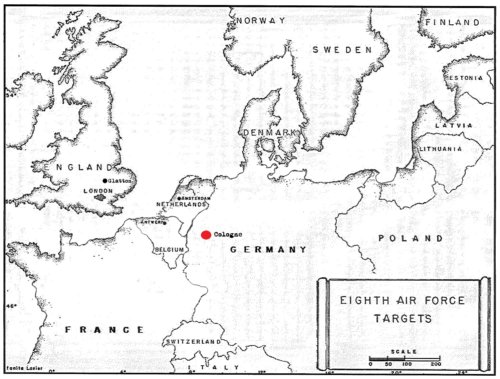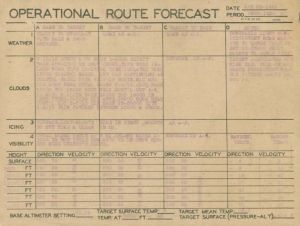TARGET: MARSHALLING YARDS
COLOGNE, GERMANY
28 JANUARY, 1945

There had been reports of considerable movement of German troops from the Western Front to the Eastern Front (the German Ardennes Offensive had been crushed). The targets were the vast marshalling yards at Cologne, where massive troop movements could be coordinated.
The 457th comprised the 94th A Combat Wing, with Major Doherty as Air Commander. Combat Wing assembly was accomplished. A wind change interrupted the time schedule and made a deviation in course necessary, placing the Group about seven miles left of course.
Proper position in the Division formation along the Division assembly line was attained.
The route from the end of the Division assembly line to the IP was flown approximately as briefed. Slight deviations in course were caused by the necessity of remaining in Division formation. Just before the IP, the Group swung wide to the right because the flux-gate compass was not functioning normally and some difficulty was experienced with the PFF equipment. However, corrections were made and the Group crossed the IF on course. Cloud coverage was ten tenths and bombing was done by means of G-H equipment in Group formation. The bombs were released from 25,000 feet.
Operational Route Forecast
After the bombs were dropped, the plane piloted by Lt. William P. Boyes left the formation near Coblenz, with one engine feathered, but apparently under control. It later crashed near Coblenz. Two crewmen lost their lives, one evaded and six were captured and became prisoners of war.
Lt. Edwin B. Benson, 457th/749th bombardier: Mission 26. Cologne. R.R. yards. Time 6.20. Low. Lead. FLAK. 3rd anniversary of 8th
Sgt. Leo I. McCombs, 457th/750th radio-operator: Take off at (empty) – landing at (empty). Carrying 10 500lbs bombs. On oxygen for 4 hours. Results were good and moderate FLAK. 6.30 hour mission.
